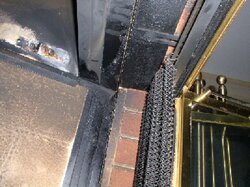E
elkimmeg
Guest
Everybody owning an insert should remove the surround trim and examine their fireplace opening. Look up at the angle front of opening and called lintel and see is all is tightly sealed also look at the damper flange. If mortar is missing or anyone can see any spacing between brick, you have a real safety problem. Most inspections are concerned with venting issues. Overlooked, is potentially very dangerous deficiencies of the original fire place design. This from a post today presents the clear and present danger.
https://www.hearth.com/econtent/index.php/forums/viewthread/382/
“To all,
This is extremely helpful.
“Elkimmeg , you pointed out about the fire… two towns over, I just looked up in that crack and there is a wood header exposed. I think you all just saved me more than my smoke problem, but you may have also saved my home and family… This information is much appreciated.”
“Again, I can not thank you all enough for this extremely helpful information.
It really concerns me that after having 3 “professional” chimney and fireplace repair personnel to look at my fireplace, that not one mentioned this crack --even after I pointed it out to them. They assured me that by just rebuilding a crown on top of my chimney, waterproofing the bricks outside the chimney, and siliconing the gap between my home and chimney that this would all stop the smoke. $400 later it obviously didn’t stop the smoke.
That’s pretty scary.”
https://www.hearth.com/econtent/index.php/forums/viewthread/382/
“To all,
This is extremely helpful.
“Elkimmeg , you pointed out about the fire… two towns over, I just looked up in that crack and there is a wood header exposed. I think you all just saved me more than my smoke problem, but you may have also saved my home and family… This information is much appreciated.”
“Again, I can not thank you all enough for this extremely helpful information.
It really concerns me that after having 3 “professional” chimney and fireplace repair personnel to look at my fireplace, that not one mentioned this crack --even after I pointed it out to them. They assured me that by just rebuilding a crown on top of my chimney, waterproofing the bricks outside the chimney, and siliconing the gap between my home and chimney that this would all stop the smoke. $400 later it obviously didn’t stop the smoke.
That’s pretty scary.”


